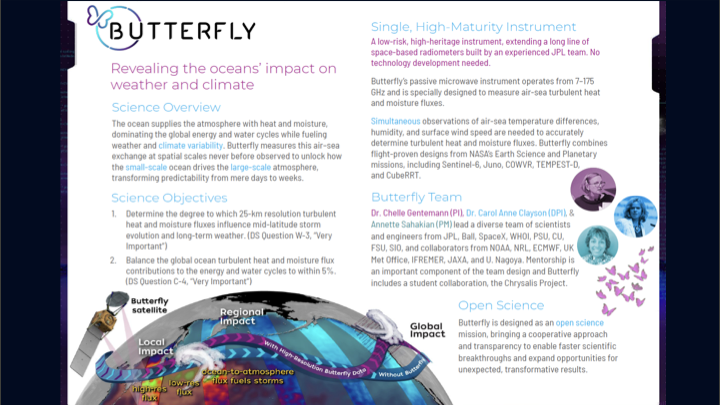Butterfly

Butterfly advances progress on some of the most important science and applications questions of NASA Earth Science for the next decade, including the coupling of the energy and water cycles, extending and improving weather forecasts, reducing climate uncertainty, and informing societal response. Butterfly is designed as an open science mission, bringing a new cooperative approach, embracing collaboration and transparency to enable faster scientific breakthroughs, and expanding opportunities for unexpected transformative results.
Coupled weather and climate models and data assimilation systems have developed the capabilities to resolve small-scale ocean features over the past decade. Recent high-resolution modeling studies suggest that small-scale ocean eddies and fronts affect the air–sea exchanges of heat and moisture and thereby impact mid-latitude storm evolution, long-term weather patterns, and change global energy and water cycles. These results paint a very different picture of air–sea interaction processes and their impacts on the Earth system from that depicted by low-resolution model simulations. However, without accurate high-resolution surface and near-surface observations to verify these models, we do not know if this is really how the Earth system works. Our current observing system is lagging behind modeling developments and does not provide accurate, small-scale heat and moisture flux data that are urgently needed to evaluate and improve models and their predictions.
To quantify the impact of small-scale ocean features on weather and climate, Butterfly collects coincident high-resolution measurements of all geophysical variables needed to estimate air–sea heat and moisture fluxes accurately: sea surface temperature and near-surface air temperature, humidity, and wind speed. These measurements fill a major gap in our knowledge of how small-scale air–sea interactions affect large-scale weather and climate, potentially extending forecast accuracy from days to weeks. Butterfly has two science objectives: (1) determine the degree to which 25-km resolution turbulent heat and moisture fluxes influence mid-latitude storm evolution and long-term weather and (2) balance the global ocean turbulent heat and moisture flux contributions to the energy and water cycles to within 5%. These science objectives are met with a small satellite carrying a single passive microwave radiometer (7–175 GHz). Butterfly is based on a series of flight-proven instruments and requires no new technology development. It includes several Earth Science Technology Office (ESTO) technology graduates, such as the wideband digital back end flying on CubeRRT and high-frequency receivers developed through an Advanced Component Technology (ACT) project and flying on Sentinel-6.
The passive microwave observations at 7–37 GHz enable retrieval of ocean-surface wind speed and sea surface temperature, 109–117 GHz enable retrieval of air temperature, and 150–175 GHz enable retrieval of specific humidity. These are the geophysical observables needed to estimate the air–sea heat and moisture fluxes required for Butterfly’s science objectives. The mission design flows from the measurement accuracy and resolution requirements. The spacecraft is sized to fit an Evolved Expendable Launch Vehicle (EELV) Secondary Payload Adapter (ESPA Grande) and uses Alternative Access to Space as a secondary payload on a Space-X launch vehicle. Butterfly is placed in a high inclination orbit at an altitude of 425 ±25 km for a two-year baseline mission. Butterfly resolves air–sea heat and moisture fluxes at <25-km horizontal resolution and reduces existing measurement errors by almost 40%. Observing air–sea fluxes advances Earth system science and improves models, leading to better weather and climate forecasts.
- Butterfly Github repository: https://nasa-butterfly.github.io/
- Butterfly proposal
- Butterfly Science
- Butterfly paper
- Butterfly Team
